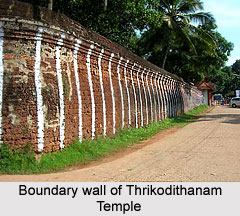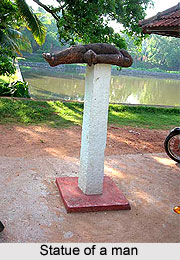 Thrikodithanam Mahavishnu Temple, also known as Adbhuta Narayanan Temple, is a famous temple located at Thrikodithanam in Kerala. It is about 2 km from Changanacherry in Kottayam District. Thrikodithanam Mahavishnu temple is among the five Pandava temples in Kerala that dates back to the 9th century. The temple has been beautifully designed and decorated with intricate deigns and paintings. Each part of the temple has been embellished and looks very attractive.
Thrikodithanam Mahavishnu Temple, also known as Adbhuta Narayanan Temple, is a famous temple located at Thrikodithanam in Kerala. It is about 2 km from Changanacherry in Kottayam District. Thrikodithanam Mahavishnu temple is among the five Pandava temples in Kerala that dates back to the 9th century. The temple has been beautifully designed and decorated with intricate deigns and paintings. Each part of the temple has been embellished and looks very attractive.
Thrikodithanam Mahavishnu Temple can be entered through two entrance and exit gates that have been built to the east and west of the temple complex. The eastern gate is the main entrance. The sanctum also known as the Sreekovil is a well proportioned, double-storied structure. It has been built on a circular plan. The base Aadhisthaana has been made up of rounded granite stones. It is almost three feet in height. Many old inscriptions can be found here in Thrikodithanam temple. These can be seen carved at the base stones. There are all together 13 inscriptions and almost all are in the Vaatezutthu Tamil script. There is also a circular wall on the Aadhisthaana that was earlier adorned with beautiful mural paintings. The entrance to the sanctum can be reached by climbing four polished black granite steps. On the either side of the steps the walls have been carved beautifully with images of various dance forms like Kudam Koothu (pot dance) and Kudai Koothu (umbrella dance). These images reflect the fact that dances had attained a high degree of excellence even by about 1100 AD. There is a small platform above the steps that forms the Mukha mandapam. Devotees gather here to receive Prasad from the priests. Many musical instruments are also kept here.
A conical roof rises in two tiers. The sloping roof has been covered with copper tile plates. The Sreekovil was renovated in circa 1100 AD. The Indian Mural paintings on the walls are only about 400 years old.
There is huge space in front of the Sreekovil known as the Namaskara Mandapam. This place is used by the devotees for special Bhajana sessions and prostrations. This Mandapam has a wooden ceiling carved with Ashtadik palakas with Lord Brahma in the middle. Images of elephants and lions have been carved along the ridges. On the southern side a small figure prostrates at full length on the granite floor. A small well occupies the North-eastern side of the Naalambalam. The main entrance into the Naalambalam is on the eastern side. There are three small doors in the other three cardinal directions.
 A large sacrificial platform made of granite known as Belikall can be seen here. Its wooden ceilings have been beautifully carved with figures riding elephants. An image of a Devi has been installed in the central portion. It is flanked by two big lotuses. An "eternal oil lamp" of recent origin hangs at the center of this chamber. A ceremonial flag mast known as Dwaja Sthamba has been erected on a square granite base. It is gold plated and rises upto a great height. There is an engraving on the base-stone that states that it was offered by a devotee named Kannakukeralan Krishnan in the year 1024 AD. There is a boundary wall that surrounds the temple. It is believed to have been built in 700 AD. The wall is about 15 feet high and 335 X 347 feet long. It is built of laterite blocks.
A large sacrificial platform made of granite known as Belikall can be seen here. Its wooden ceilings have been beautifully carved with figures riding elephants. An image of a Devi has been installed in the central portion. It is flanked by two big lotuses. An "eternal oil lamp" of recent origin hangs at the center of this chamber. A ceremonial flag mast known as Dwaja Sthamba has been erected on a square granite base. It is gold plated and rises upto a great height. There is an engraving on the base-stone that states that it was offered by a devotee named Kannakukeralan Krishnan in the year 1024 AD. There is a boundary wall that surrounds the temple. It is believed to have been built in 700 AD. The wall is about 15 feet high and 335 X 347 feet long. It is built of laterite blocks.
The temple also has a sacred pond that is located near the eastern entrance. It occupies an area of about 50X50 meters. A fleet of steps leads to the pond and a cement partition separates bathing areas for women and men. The pond is also called Pancha Teertham as it is believed that it has been formed by the amalgamation of five sacred water sources.
Between the pond and the eastern entrance is a strange granite statue. It is located near a public platform for arts and discourses. The statue is of a man lying flat on his back, held up stiff and straight on a stone pillar about six feet high. Only his waist rests on the pillar, rest of the body is unsupported. He holds a Shankha (conch shell) in his left hand and wears the holy thread indicative of the higher castes. At one time the statue wore a crown as well.











